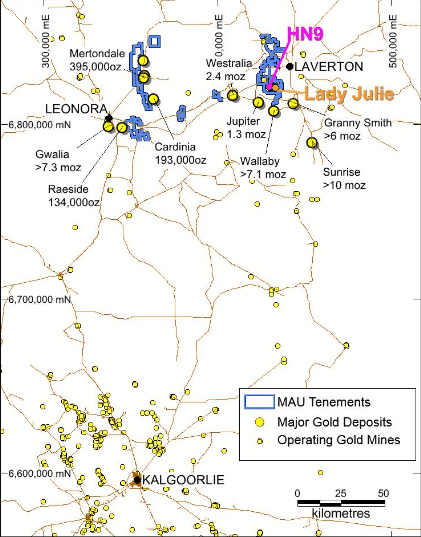Magnetic sees potential for large-scale shallow deposits at Lady Julie

Further infill RC and diamond drilling is planned with the aim of ultimately converting to an indicated resource. Pic: jhorrocks (iStock / Getty E+) via Getty Images.
Magnetic Resources’ recent infill and extension drill program at Lady Julie has found both thick and high-grade zones starting from surface.
Managing Director George Sakalidis said that with the Australian gold price at near record levels of $2503, the HN9 Project area encompassing HN5, HN6, HN9 and Lady Julie is shaping up and has potential for large-scale shallow deposits.
Not to mention it’s only 15km NW of the Granny Smith Operations owned by Gold Fields Australia Pty Ltd and only 10km NE of the Jupiter Operations owned by Dacian Gold (ASX:DCN) and 35km north of the Sunrise Dam deposit owned by AngloGold Ashanti (ASX:AGG) at Laverton, WA.
“The multiple, shallow intersections that start from surface are exciting at Lady Julie North with intersections of 24m at 4.4 g/t from 0m in MLJRC348, 22m at 4.1 g/t from 0m in MLJRC457,” Sakalidis said.
“These shallow zones continue downdip and thicken as shown in with an intersection of 88m at 1.3 g/t from 68m in MLJRC448 and 18m at 4.7 g/t from 142m in MLJRC404.
“These mineralised zones are open to the SE. Some of this infill drilling is ascertaining the extent of some very-high grade zones greater than 10 g/t, including 2m at 21.4 g/t from 43m in MLJRC292 and 4m at 15.1 g/t from 32m in MLJRC453 and 1m at 59.5 g/t from 22m in MLJRC348 – that lie within the promising thicker intersections.
“The thicker porphyry zones on the eastern side of the Lady Julie1 mineralised zones are being tested at depth looking for underlying deeper mineralised intrusions similar to Sunrise Dam.”
15 high grade gold targets
Within the HN5, HN6, HN9 and Lady Julie areas there are a total of 1,626 shallow intersections (ranging from 1 to 30m) greater than 0.5g/t gold – which includes 717 greater than 1 g/t, 269 greater than 2 g/t, 148 greater than 3 g/t and 91 greater than 4 g/t.
The results from the 2D seismic survey and Magnetic Resources’ (ASX:MAU) recent major drill programs as well as historical drillings results have led to the interpretation of 15km of gold targets in 10 areas within HN5, HN6, HN9 and Lady Julie.
The best-looking target so far besides the 3km-long HN9 mineralisation, is Lady Julie North (3.9km long).
Lady Julie North includes the outstanding intersection of 41m at 2.6 g/t gold from 31m including 15m at 4.2 g/t from 52m (MLJRC162), and 25m at 4.4 g/t from 0m (MLJRC348) and 36m at 2.0g/t from 92m (MLJRC448).
This zone between the two thrusts is very prospective and there are numerous NS workings, mineralised drillholes and anomalous soil geochemical areas, which are in the process of being further drilled.

Infill drilling planned to convert an indicated resource
The next drill program of 33 RC holes for 3578m will be testing between 100 to 250m depth looking for further enriched zones, defining the different stacked zones and vertical mineralised shoots.
This program will also assist in the location of deeper holes into the underlying porphyry and porphyry contact positions.
The company says the very high-grade intersection zones are associated with pervasive vertical zones (shoots) with grades greater than 10g/t.
Some of these intersections include:
- 2m at 21.4 g/t from 43m in MLJRC292;
- 2m at 21 g/t from 3m in MLJRC457;
- 1m at 59.5 g/t from 22m in MLJRC348 and;
- 4m at 15.1 g/t form 32m in MLJRC453.
Further infill RC and diamond drilling is designed to test and extend all the gold mineralisation found with the aim of ultimately converting to an indicated resource.
Shallow mineralised zones show upside potential
There are now at least two discernible mineralised lodes recognised that mostly dip shallowly between 20-45° to the east at Lady Julie.
Magnetic says they are a potential indicator for deeper mineralisation because all the numerous nearby large deposits in the region including Wallaby (7Moz), Sunrise Dam (10Moz) and Jupiter (1.3Moz) have persistent internal shallow-dipping mineralised lodes and have been defined down to 1500m depth at the Wallaby deposit.
Many discoveries in recent times have been made by drilling below 100m because the historical drilling was far too shallow.
And at HN5, 6, 9 and Lady Julie the average hole depth is only 69m – which the company says providing tremendous scope for upside potential.
This article was developed in collaboration with Magnetic Resources Limited, a Stockhead advertiser at the time of publishing.
This article does not constitute financial product advice. You should consider obtaining independent advice before making any financial decisions.
Related Topics

UNLOCK INSIGHTS
Discover the untold stories of emerging ASX stocks.
Daily news and expert analysis, it's free to subscribe.
By proceeding, you confirm you understand that we handle personal information in accordance with our Privacy Policy.








